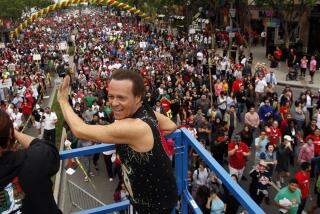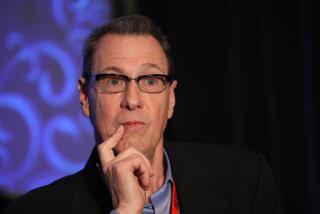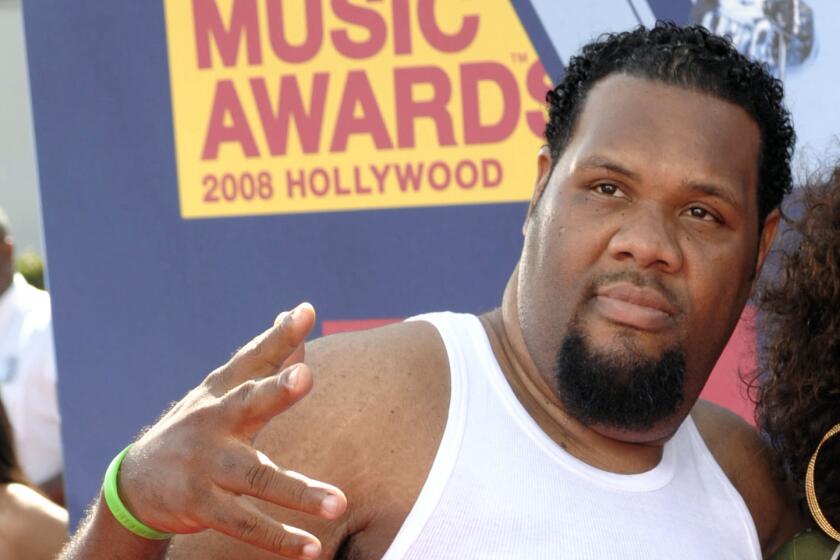From the Archives: Lionel Hampton, Virtuoso on the Vibraphone, Dies
Lionel Hampton, the irrepressible bandleader who played with an infectious joy that captivated fans around the world and, in the process, gave the vibraphone a lasting place on the jazz bandstand, died Saturday morning at Mt. Sinai Medical Center in New York City. He was 94.
In failing health for several years after a series of strokes, Hampton was admitted to the hospital Wednesday. The cause of death was heart failure, said his manager, Phil Leshin.
A dynamic showman with an electric personality, Hampton was one of the last giants of jazz. He spent many of his formative musical years in Los Angeles, playing with top local bands and some great national figures as they came through town. Among them were Louis Armstrong—who first encouraged him to play the vibraphone—and, later, Benny Goodman.
Hampton went to New York City with Goodman and became part of the first openly integrated performing band, which also included drummer Gene Krupa and pianist Teddy Wilson.
As a bandleader in his own right, Hampton was a major influence on a generation of players who would become leading names in jazz. Among them were Clifford Brown, Betty Carter, Dexter Gordon, Illinois Jacquet, Quincy Jones, Charles Mingus, Wes Montgomery and a young singer from Chicago who called herself Ruth Jones, until Hampton told her to change her name to Dinah Washington.
Quincy Jones, now a multi-Grammy Award-winning producer, first worked for Hampton in 1948 when he was just 15. He credits Hampton as one of the people who gave him his start in music. He issued a statement Saturday in Los Angeles on Hampton’s passing:
“It is difficult to find the words to describe the deep sadness that I have today. In our more than 50-year relationship ... Lionel Hampton was a mentor, collaborator and friend to me. Hamp was the consummate jazz artist.... I cut my teeth writing arrangements for Lionel Hampton, and there was no better school in the world than the Lionel Hampton Orchestra. He taught me how to groove and how to laugh and how to hang and how to live like a man.”
Jones’ efforts to play for Hampton in 1948 were ultimately foiled by the bandleader’s wife, who sent the teenager back to school in Seattle. In 1950, Jones rejoined Hampton’s orchestra as an arranger and trumpeter. He wrote his first composition, “Kingfish,” and toured with the band throughout the South and in Europe.
Hampton was among the first blacks to play at a presidential inauguration—Harry Truman’s in 1949—and played at several other inaugurals after that. In 1981, he was honored at the White House by President Reagan; years later, he returned to be celebrated by President Clinton.
Through all of it, Hampton once said, he had just one goal: “I want to be remembered for spreading happiness and goodwill.” Over the years, observers said he did just that.
“So far as there is joy in jazz, he personified it,” one critic, Nat Hentoff, said Saturday. “He meant it and he felt it.”
Hampton’s age, date of birth and place of birth were open to question throughout his career. But in his autobiography, “Hamp,” written with James Haskins, Hampton said he had been born on April 20, 1908, in Louisville, Ky.
Hampton was raised in Chicago by his grandparents and an uncle. For school, he was sent to Holy Rosary Academy in Collins, Wis., where he learned the rudiments of band drumming from nuns.
When he returned to Chicago, he was greatly influenced by his uncle, Richard Morgan, a well-known bootlegger who threw some of the best parties and attracted some of the top jazz and blues stars of the day.
It was not uncommon for young Hampton to encounter such notables as Alberta Hunter, Jelly Roll Morton, King Oliver and Bessie Smith—and occasionally white musicians such as Bix Biederbecke—at his uncle’s parties, which often turned into all-night jam sessions.
His uncle encouraged Hampton’s musical interest and young Lionel played drums in a boys band organized by the Defender, one of the city’s leading black newspapers.
Hampton developed quickly as a musician and learned to play by ear. By his second year in high school, he was playing professionally in a band led by saxophonist Les Hite, who later encouraged Hampton to join him in Los Angeles, in 1927.
In the late 1920s, Los Angeles was a hotbed of jazz, with a lively club scene and fine regional bands. Hampton, still a drummer in those days, studied musical theory at USC, and played with a few local bands, including one fronted by Hite at the Cotton Club, a Culver City nightspot across from MGM. The club’s owner hired Armstrong to come in for an engagement in 1930, with a plan to use Hite’s band to accompany him. Hampton, Armstrong and the rest of the Hite band went into the studio to cut a record.
During a break in the recording session, Hampton and Armstrong came across what Hampton’s autobiography referred to as a vibraharp in a side room, and Armstrong asked Hampton if he could play it. Hampton later wrote that he thought the keyboard was similar to that of a xylophone, which he had studied in Chicago, and told Armstrong he could.
According to his autobiography, Hampton pulled the instrument into the studio, plugged it in and played a solo that he had memorized from one of Armstrong’s records. As the story goes, Armstrong was knocked out by the sound of the vibraphone and told Hampton he wanted the younger musician to play the instrument on the Eubie Blake song “Memories of You.” Forty-five minutes later on that October day in 1930, Hampton, according to most experts, first played a vibraharp as a serious instrument on a jazz recording.
Through the rest of the year, Hampton continued his Cotton Club work and did some additional recordings with Armstrong, playing both drums and vibraharp. Live broadcasts from the club helped his standing in the California jazz community, and Hampton got steady work up and down the coast.
Hampton met Gladys Neal, a young woman who worked at MGM, in 1929, and she became his steady companion, then his business manager and later his wife. By all accounts, she was a formidable businesswoman who kept a close eye on the money coming in and the money going out. She handled his business affairs so astutely with investments in real estate around the country that he eventually became a wealthy man.
She also gave his career some focus, urging him to buy a set of vibes and start his own group. By the mid-1930s, Hampton was fronting his own band but, as the Depression, deepened the band wasn’t doing all that well financially.
In 1936, the group was working at the Paradise Cafe, a jazz spot on 6th and Main streets in downtown Los Angeles, when the influential jazz producer John Hammond came in to hear Hampton play the vibes. Benny Goodman and his orchestra were in town for a two-week engagement, and the next night Hammond persuaded Goodman to visit the club to hear Hampton.
Goodman liked what he heard, and returned with drummer Krupa and pianist Wilson. A jam session ensued, and Goodman hired Hampton, forming the distinctive Benny Goodman Quartet that was the orchestra’s slick display piece.
Within days, Hampton was recording with Goodman, Wilson and Krupa at a Los Angeles studio. It was the first Benny Goodman quartet recording; by the time Hampton joined the others in New York, the record was selling briskly across the country.
“Hampton had a tremendous sense of rhythm, and he transferred that to the vibes,” said Dan Morgenstern, director of the Institute for Jazz Studies at Rutgers University. “He could really swing, and that’s what captured Benny Goodman. He had a great ear and could improvise.”
Hampton made his debut with Goodman’s quartet at the Madhattan Room of the Pennsylvania Hotel in New York City on Nov. 21, 1936. Some observers predicted that race riots would ensue to block the performance of an integrated band, but the only noticeable public outcry was in the demand for tickets for subsequent concerts. The quartet later moved to the larger Paramount Theater and played to packed crowds for several weeks.
Hampton spent four years with Goodman, and recorded extensively with the quartet. He also occasionally played in the big band, taking over on drums after Krupa left Goodman in 1938.
While with Goodman, Hampton made a number of memorable records for RCA Victor with some of the leading names from big bands coming through New York City. These Hampton small-group recordings, done in the late 1930s, are considered by jazz critics to be among the finest of their kind.
When Goodman broke up the quartet in 1940, Hampton went out on his own and formed a big band. Hampton’s band was an immediate crowd-pleaser that featured raw, energetic solos, a powerful brass section and dominating saxophones.
The driving excitement of the Hampton band was never greater than when it played his theme, “Flyin’ Home.” During one frenzied rendition of the tune at Harlem’s Apollo Theater, the audience’s stomping created a crack in the balcony, ending the performance.
Hampton’s joyful grunting and unrestrained, swinging vibes style became known by jazz fans throughout the world. He toured Europe and Japan and other countries around the globe.
When he visited Israel, he was inspired to write a four-part symphonic jazz work, “King David,” reflecting his spiritual attachment to the infant nation.
Hampton penned his signature tune “Flyin’ Home” while he was playing with Goodman in 1939. Other memorable compositions include his original ballad “Midnight Sun,” written with Sonny Burke, and his “Blues Suite.”
Although the band was highly successful and, by the end of the 1940s, was grossing a million dollars annually, changing national tastes in music meant that Hampton eventually had to settle for a smaller group. In the mid-1960s, he began to travel with an eight-piece combo that he called the Inner Circle.
While a strong supporter of human rights causes, including an end to apartheid in South Africa, Hampton did not fit into any commonly accepted political mold.
He was a staunch Republican, but supported President Johnson, a Democrat, after Johnson signed the Voting Rights Act in 1964. In California in the 1940s, he supported a young congressional candidate named Richard M. Nixon, played at rallies for him, and would continue to support him throughout Nixon’s political career. In 1980, he was one of six New York state delegates elected to support George H.W. Bush for the Republican presidential nomination.
Tragedy befell Hampton in 1997, when he lost most of his vast collection of memorabilia, his music, photographs and vintage record collection in a fire at his high-rise apartment in New York City. Undaunted, two days later he arrived at the White House wearing a borrowed suit to receive the National Medal of Arts from President Clinton.
President Bush issued a statement Saturday saying, “He was an American music legend and will be sorely missed.”
Hampton received numerous awards over his long career, including a jazz masters fellowship from the National Endowment for the Arts in 1988 and the Kennedy Center Lifetime Achievement Award in 1992.
In 1987, the music school of the University of Idaho was named in his honor. It annually presents a four-day Lionel Hampton jazz festival at its campus in Moscow, Idaho. Pepperdine University is just one of many educational institutions to give Hampton an honorary degree.
One of Hampton’s most visible accomplishments was a four-building, 355-unit, low-income apartment complex in Harlem, which he helped finance.
One of the high-rise apartment houses was named for his wife, who died of a heart attack in 1971, the year the project began. They had no children.
Despite his generosity to others, Hampton will be best remembered for his contributions to jazz.
“He was the definition of swinging,” Hentoff said Saturday. “The core of jazz flowed out of him, just as it did out of Armstrong.”
Funeral arrangements were pending.
From the Archives: Renowed Jazz Bassist Charles Mingus Dies at 56
From the Archives: Ella Fitzgerald, Jazz’s First Lady of Song, Dies
Louie Bellson dies at 84; Duke Ellington called him ‘the world’s greatest drummer’
From the Archives: Miles Davis, Jazz Legend and Innovator, Dies at 65
From the Archives: Frank Sinatra, Premier Vocalist of His Time, Dies at 82
More to Read
Start your day right
Sign up for Essential California for the L.A. Times biggest news, features and recommendations in your inbox six days a week.
You may occasionally receive promotional content from the Los Angeles Times.






